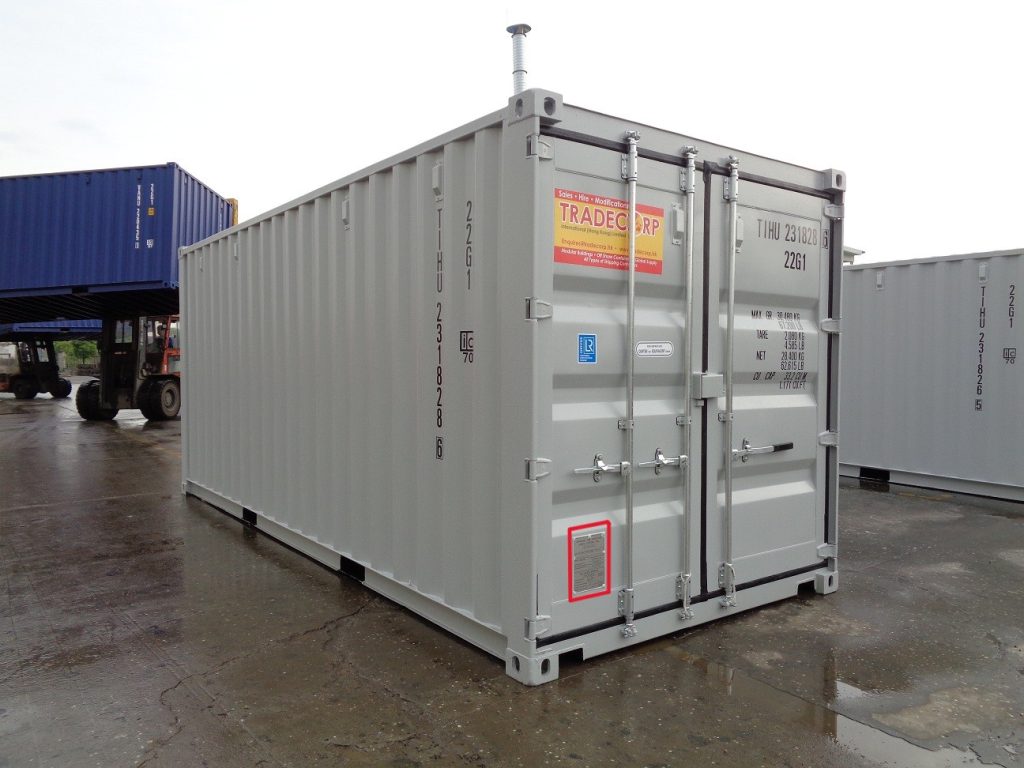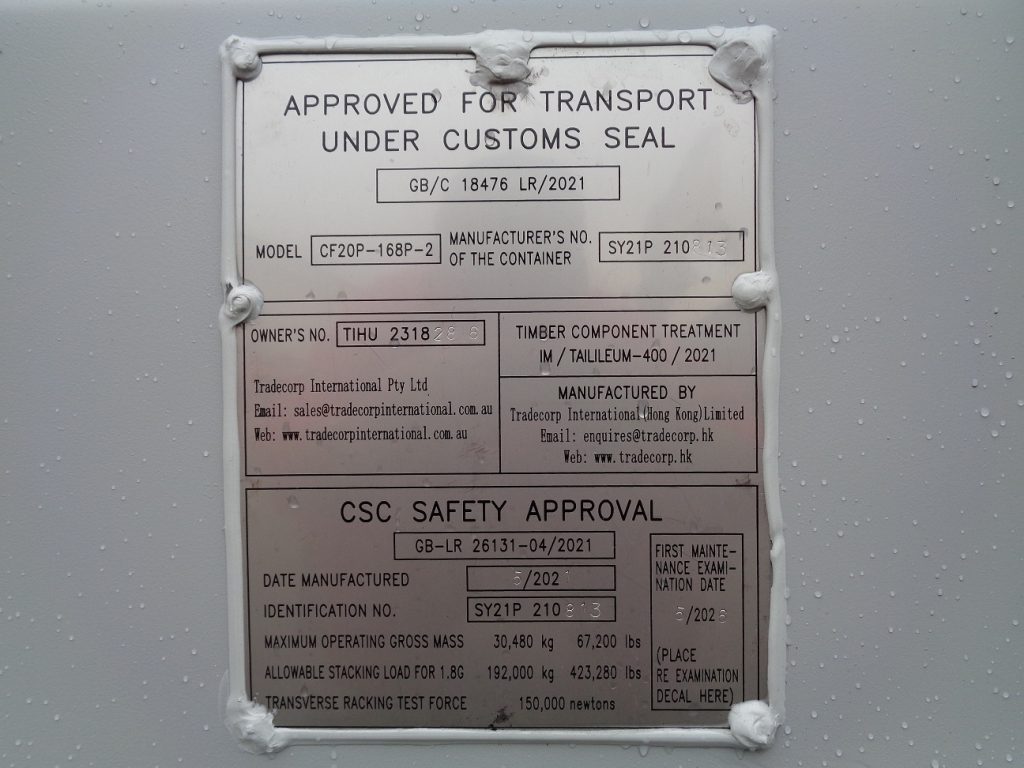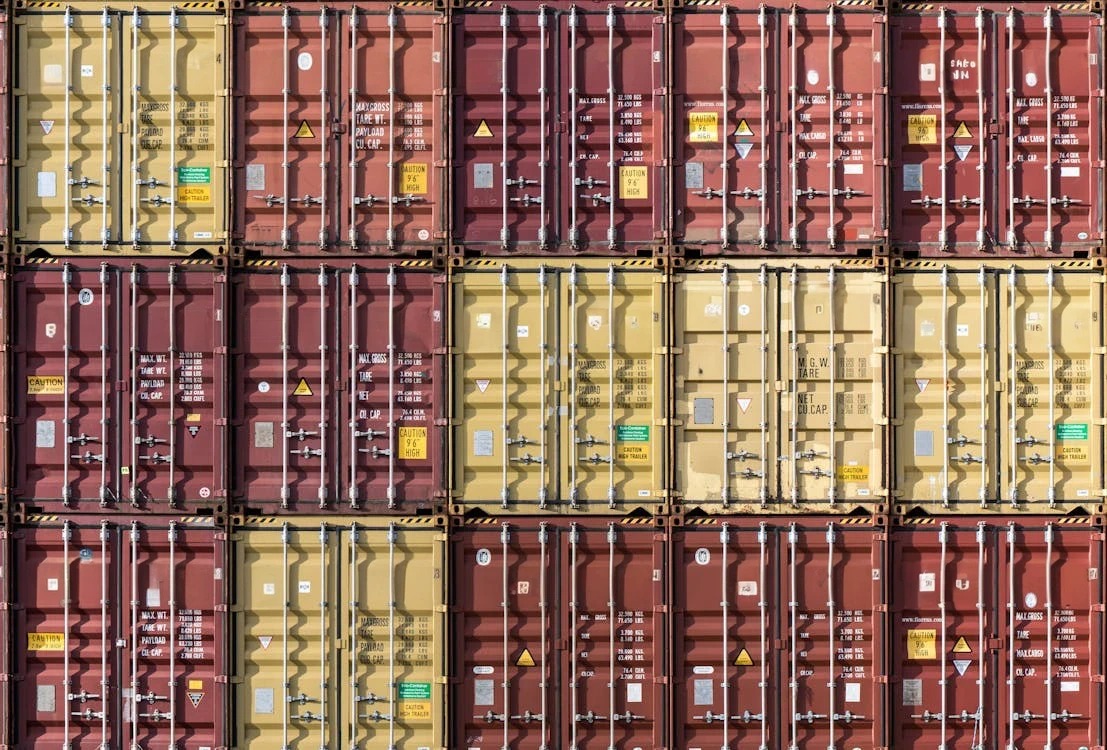Much like any piece of machinery worth several thousand dollars, freight cargo containers must have a license to allow them for regular use. Such a license is known as a Convention for Safe Containers (CSC) plate, something people now usually see in regular shipping containers.
Considering the intricacies and rigors of maritime transportation, installing a CSC plate in a shipping container is a must. In fact, freight cargo containers without CSC plates must have them first if people are even going to use them for business.
Why are these plates then so important for everyone involved in the industry? Tradecorp will explain the reasons in detail here!
Also Read: Suitable Sea Container Types for Oil Rigs and Offshore Sites
Definition and Origins of CSC Plates

To put it simply, a CSC plate is a metal certification plate manufacturers attach to a shipping container. It confirms that the container complies with the International Convention for Safe Containers (CSC), a set of global safety standards from the International Maritime Organization (IMO) in 1972.
Before the convention existed, there were no globally recognized regulations for shipping container safety. Different countries had their own rules, making international trade inefficient and hazardous at times.
Seeing this problem, the CSC Convention solved this issue by introducing uniform safety standards for container construction, maintenance, and inspections.
Since its inception, a CSC plate’s purpose has been to ensure that all containers people use in global shipping meet certain requirements.
These requirements state the containers must be structurally sound, can handle extreme conditions, and be safe for workers handling them.
The plate also streamlines international trade by providing a universally accepted certification that customs officers, shipping companies, and regulatory authorities can trust.
Because of that, all shipping containers for international shipping must have a CSC plate. This certification guarantees that the container has passed rigorous safety tests and is fit for any transport mode.
Contents of a Shipping Container’s CSC Plate

For people unfamiliar with freight cargo containers in general, understanding their CSC plates’ content can be a handful. Luckily, a guide below by Tradecorp can help anyone understand the information from the plate:
- Container’s Unique Identification Number
Every shipping container has a unique identification number, typically composed of a four-letter owner code, a six-digit serial number, and a check digit. This helps authorities, shipping companies, and container owners track and verify the container.
- Date of Manufacture
This detail is crucial because it determines the container’s age and when its first CSC inspection is due.
- Maximum Gross Weight
This specifies the heaviest total weight the container can carry, including both the container itself and its contents.
- Transverse Racking Test Force
This information mentions how much force you can apply to the container’s top edge before the container’s frame warps.
- Stacking & Racking Test Loads
Shipping containers are stacked on top of each other during transport. The CSC plate includes data on the maximum stacking weight and racking test results to ensure the container can handle pressure from other containers.
- Approval Number
This is a unique code assigned by the government authority that approves the container’s design. It confirms that the container’s construction follows international safety standards.
- Exam Date & ACEP/PES Markings
The CSC plate includes the date of the last inspection and indicates whether the container is under ACEP (Approved Continuous Examination Program) or PES (Periodic Examination Scheme).
While the format can change from one container manufacturer to another, all these elements at least must be mentioned. By mentioning them, customers can determine if the container suits the nature of their cargo.
Types of CSC Plate Inspections

As it stands, there are two ways to inspect the container’s condition to determine if it can receive a CSC plate.
Approved Continuous Examination Programme (ACEP)
The Approved Continuous Examination Programme (ACEP) is a maintenance-based inspection system where experts check the container regularly during their routine use.
Instead of setting fixed examination dates, containers under ACEP are examined during normal operations, such as when they are repaired, refurbished, or stored at depots.
This system is particularly useful for large shipping companies that frequently maintain and inspect their fleet. As long as the container is in active service and regularly monitored, it remains CSC-compliant.
However, ACEP programs must receive approval from the relevant government authority to become effective. Not to mention companies using ACEP must prove that their maintenance procedures meet international safety standards.
Periodic Examination Scheme (PES)
The Periodic Examination Scheme (PES) is a more traditional approach to CSC inspections. Under PES, surveyors assess containers at least once every 30 months to ensure they remain structurally sound.
The first inspection must take place within five years of the container’s manufacture date. After that, every subsequent inspection must occur at least every two and a half years (30 months).
During inspections, surveyors should accurately search for any damage, corrosion, and structural integrity issues.
PES is common for containers that are not part of a large, actively maintained fleet. If a container fails an inspection, you can only use it again after necessary repairs and it passes re-certification.
Why Is Having a CSC Plate in Your Shipping Container Important?
There are several reasons why equipping a CSC plate in your shipping container is important and not just for the sake of formality:
- Ensures Safety
Containers undergo rigorous testing before certification so they can withstand extreme weather, stacking loads, and transportation stress.
Without proper certification, there’s no guarantee that a container is fit for use. The unwanted risk of structural failures will also stay there since there are no checks.
- Required for International Shipping
Without a valid CSC plate, you can’t use the container for overseas transport. Customs authorities and shipping lines will reject non-certified containers, which can cause costly delays and logistical headaches.
- Reduces Liability Risks
If a non-certified container causes an accident, authorities can hold you legally and financially responsible. Having a CSC plate minimizes liability risks and ensures the container meets all necessary safety regulations.
- Proves Structural Integrity
A CSC plate reassures buyers, renters, and logistics companies that the container can last decades. Furthermore, certified containers have a higher resale value and are easier to lease or sell.
For businesses involved in freight shipping, leasing, or repurposing containers, a valid CSC plate is a must-have for compliance and peace of mind.
What Happens If Your Container Does Not Have a CSC Plate?

While CSC inspections can take some time and might look tedious, you should do them either way rather than suffer these problems:
- Shipment Rejections
International shipping lines will not accept non-certified containers, leading to delays and financial losses.
If a container arrives at a port without a valid CSC plate, the port will not load it onto a cargo ship. As a result, there can be a significant logistical backlog.
- Safety Risks
Without proper certification, there’s no guarantee that the container is structurally sound. A compromised container can lead to collapse, cargo loss, or serious injuries to workers handling it.
- Legal Issues and Fines
Many countries punish businesses that use uncertified containers in international shipping. These penalties can include fines, cargo seizures, and operational restrictions.
- Decreased Resale Value
A CSC-certified container is easier to sell or lease. Without a plate, the container’s market value drops significantly, as buyers prefer certified units for safety and compliance reasons.
If your container doesn’t have a CSC plate, getting one should be a priority to avoid costly setbacks.
How to Get a CSC Plate for Your Container

If your container doesn’t have a CSC plate, you’ll need to go through an inspection and certification process to use the container later.
Firstly, you can contact a certified inspector or classification society approved by the IMO. They will assess the container’s condition by looking for damages, corrosion, dents, and load-bearing capacity.
Next, the container must undergo weight and racking tests to ensure it meets safety standards. If the container passes the inspection, the organization issues a CSC plate and approval number.
Once surveyors certify the container, the container must undergo periodic inspections based on ACEP or PES regulations. All in all, while the certification cost varies, it’s a small price to pay for safety, compliance, and shipping eligibility.
Additional Best Practices for CSC Plates
Apart from mentioning all the container’s important information in the CSC plate, there are other ways to improve its usefulness for freight cargo containers.
One way to do it is by using photosensitive anodized aluminum as the plate’s construction material. Long prized for its survivability in harsh environments and durability, container builders often use this metal to build their CSC plates.
By using this metal, CSC plates can last up to 20 years. While this benefit is already a steal, you can protect the plate’s images further by using an extremely hardy anodized layer.
The layer has a hardness nearly similar to sapphire, some of the hardest minerals according to the Mohs scale. With such hardiness, any damage from corrosion and sunlight to saltwater can no longer damage your CSC plate and the container.
Also Read: How Much Does a Shipping Container Weigh: A Breakdown
Conclusion
By this point, you can see why CSC plates are so important for freight cargo containers anywhere. However, only trusted container manufacturers like Tradecorp follow the best practices in providing CSC plates to their containers. Contact Tradecorp via its quote form to explore its container products with proper certifications and compliance with ISO standards!

